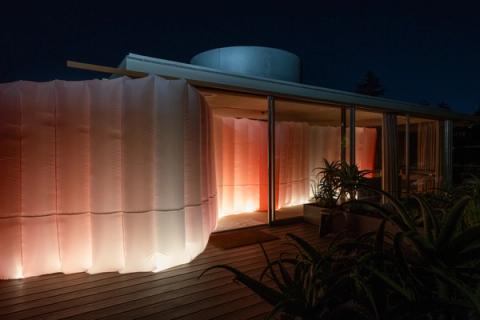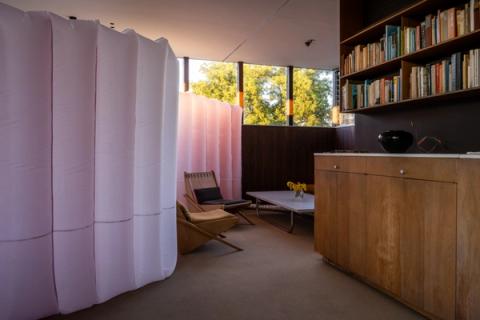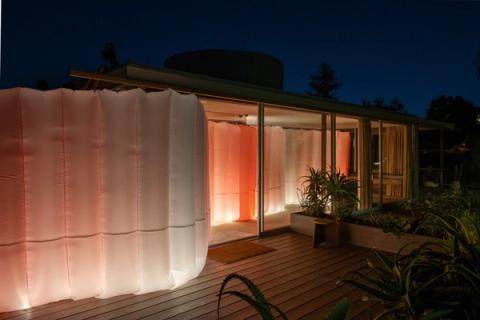Oct 16 —
Oct 22,
A House For More
Fernanda Canales
Installation: Walking Walls
Fernanda Canales + Pablo Kobayashi
With millions of vacant homes in the world and millions of people without a house, architecture has the potential to provide alternatives against segregation: it can provide more, for more people. A House For More is a workshop and exhibition at the VDL Studio and Residences House conducted by Mexico City-based architect Fernanda Canales to question underused spaces in houses and introduce collective programs in the places we inhabit. Houses account for the largest built space in the planet, but are still designed to address individual desires that disregard collective implications. In the next decades, architects will deal more and more with existent constructions rather than building from scratch. Despite the growing demand for mix-use buildings, most of the residential land in the United States is still for single-family detached houses, and it is illegal to build any other type on 75% of the residential land in many cities, including Los Angeles, Seattle and Chicago. 1 This workshop addresses the necessity to reinstate in homes their collaborative and productive nature. The intention is to occupy VDL House turning its inside outwards in order to imagine post-domestic futures.
The VDL Studio is an extraordinary example of the demand for transformations of the housing stock: built in 1932 by Richard Neutra as an offi ce and a house for two families, it was expanded in 1940 to introduce a garden house, redesigned in 1963 by Neutra and his son Dion after a fi re destroyed the original house, and now is host to cultural programs, exhibitions and residencies. A true laboratory of the need to expand housing programs and blur the divisions between the domestic realm and everything that is left outside, the VDL Studio will be turned into an installation to rethink ways of reusing vacant spaces and make the public realm enter. The aim is to expand the meaning of "house" by breaking down two erroneous premises —the house as a place of rest, separated from work the house as private property, and the house as a sanctuary for the nuclear family— in order to achieve other forms of coexistence.
Defining a place of one’s own implies demarcating it in some way, and our future will depend on how we decide on these demarcations. This proposal questions the definitions of ownership to move beyond the idea that a person is defined by his or her individual property. The intention is to make the house an example of how buildings can be regarded not as isolated entities but as an extended bed for all, where the need for privacy is compatible with the needs of others. A House For More alludes to the demands for more programs associated to living spaces, for more people, and obtaining more from the existing housing stock (today, roughly 40 % of home space is used for storage). Fernanda proposes to imagine worlds of our own that are also worlds for others.
The intervention will consist of two parts: the first will be a research and theoretical workshop, in which Fernanda will engage with Cal Poly Pomona students during 4 weeks focusing in historical references that have challenged the definitions of home. The study will be centered in projects of domestic reformers such as Melusina Fay Pierce who started the Cooperative Housing Movement in Boston in 1870 and Alice Constance Austin who designed The Socialist City in Llano del Rio California in 1915 based in centralized collective services. Participants will design alternatives to outspread the VDL House using inflatable partitions. The second part will be an installation done in collaboration with Pablo Kobayashi that will extend the house outwards to use the vacant roofs and accommodate varied activities for more people. The boundaries between public and private will be challenged using movable cloth walls intended to provoke us to question how much we are willing to share.
A site-specific piece done by Fernanda Canales and Pablo Kobayashi, expert in temporary installations and pneumatic structures, will be built for the exhibition at the VDL Studio in October 21, 2023. The installation consists of 6 inflatable walking walls that will allow students and visitors to extend the space and insert varied uses into the existing house. Architecture becomes a fl exible element that changes responding to human interaction. The wall stops being a fixed element and becomes a lightweight, playful component that takes different shapes according to improvised forms of occupation. Walls are carried effortlessly (2 people can move a 6-meter-long partition), literally providing walls that walk along inhabitants and follow their needs. The intention is to understand walls as elements that connect rather than divide.
In collaboration with Cal Poly Pomona Students:
Cole Carlson, Ahmad A. Chehab, Brandon Cerezo, Jonathan Gallegos Daza, Alex Gomez, Anthony I. Gonzalez, Sana Iqbal, Ana Z. Jaimes, Haniya Khan, Tamari Leps, Trey Nicholas, Amy M. Pagaria, Benjamin Ramirez, Jeric C. Rosal, Jonathan Vargas, Kimberly Yan, Jose De Jesus J. Zavala.
This program was made possible with the support of the State Norpell Workshop and Lecture Series.







